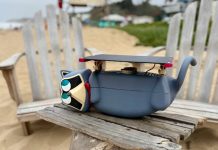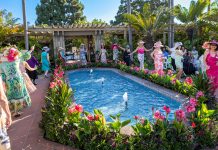
Groups of Sage Hill students recently showcased their efforts to make a difference locally and globally.
Students presented their service learning projects recently at the Two-Way Street Project: A Service Learning Expo event. The student presentations included videos, photos, posters and speeches. Each group also had to keep a blog about their experience, said Torrey Olins, the director of communications and marketing for Sage Hill.
“The service learning program creates opportunities for our students to make a difference in ways they never thought possible,” said Jason Gregory, the school’s director of community life and public purpose.
The expo celebrated the student accomplishments of Sage Hill School’s service learning program for the current school year. The program is part of the school’s public purpose initiative and allows students to apply what they have learned in the classroom to real life experiences through local outreach.
“They get a whole new sense of themselves. It pushes their boundaries, their comfort zones,” Gregory said. “It definitely teaches them something about themselves.”
Sage Hill students, staff and parents attended the expo, as well as almost 350 students and parents from three local elementary schools that worked with the Sage Hill freshmen and sophomores. This was the first time the event was held in the evening, allowing parents from the visiting schools to attend, Olins said.
The underclassmen worked with students from El Sol Academy, and Killybrooke and Wilson elementary schools for their service learning projects.
The freshmen class helped work on science projects with third and fifth graders while the sophomores helped fourth graders with their creative writing and storytelling projects.
Juniors can either work with a local organization that the school has partnered with or design their own independent project.
The experience year to year builds a great foundation for the students to be successful when they create their own project during their senior year.
The senior students developed their own projects in connection with their academic work and interests. They can choose one of the school’s existing partners, work with an organization through an upper level class, make their own connection to a charity or organization or design their own independent project.
All the projects had to provide some kind of service or fulfill a community need, said Olins.
The upperclassmen projects included microloaning to entrepreneurs around the world, organizing and holding the school’s first ever math invitational, planting the school’s first on-campus organic garden, acting in an anti-bullying program, granting local wishes for Make-A-Wish Foundation, teaching kids from the Boys and Girls Club of America how to fish and many more.
There were 48 presentations at the event, which ranged from groups of two to 20 students.
Just one of the service project groups included 15 students from Pete Anderson’s AP Economics class. They decided to continue last year’s project through Kiva, an organization that connects impoverished entrepreneurs around the world with individual lenders in an attempt to alleviate poverty through microfinancing.
Kiva helps entrepreneurs get the “kick start” they need to get their business going, the students explained during their presentation.
Over the past two school years, the Sage Hill Kiva group has made over 80 microloans totaling more than $2,000. All the students in the group this year made at least one loan.
“The Kiva project really represents the vision and mission behind the program,” Gregory said. “And it’s a concept that changes lives around the world.”
Kiva works with microfinance institutions, called field partners, on five continents to provide loans to people without access to traditional banking systems. Kiva sends 100 percent of the loan to the field partners, who then disperse it as soon as it is needed.
The field partners also collect loan details, stories, photos and bio information from the entrepreneurs and then uploads all of it to www.kiva.org. Volunteer editors and translators review the loan requests and publish them online so potential lenders can know exactly to whom, for what and where their money is going.
The Sage Hill group also has their own page, www.kiva.org/team/sagehill, allowing others to join their team and add to their group’s total amount loaned.
The group explained how Kiva worked, what they did throughout the year and answered questions during their presentation.
The main goal of the group project was to spread the word about Kiva and hopefully sign up new lenders, they said.
They set up information booths at school and around Newport Beach on every service learning day. They even made a trip to the dog beach, bringing their own pooches and one turtle along with them, to try and get more people interested in Kiva.
The group also worked a booth at the Sage Hill Multicultural Fair on March 26. While they sold soda and water they told visitors about Kiva.
“The day was a success and the venue was a great way to continue getting the word out about Kiva because people from all over Orange County came to the fair,” according to the group’s blog, www.sagehillapeconkiva.wordpress.com.
All of the service learning project groups were required to keep a blog.
One of the independent service projects, Fishing for Future, posted the proposal for their idea on their blog, www.fishingforthefuture.blogspot.com.
Jeffrey Tedmori and Sean Batten detailed why they wanted to do the fishing project and how it would help the community.
It’s important that the students work on a project that involves an issue or subject matter they are passionate about. In its simplest form, Gregory said, the project allows kids to do their part to make a difference and make the world a better place.
Tedmori and Batten teamed up with the Santa Ana Boys and Girls Club to promote catch and release and teach underprivileged kids how to keep the environment sustainable.
“These kids would most likely never be able to go fishing, and we would like to introduce them to something that they can do for the rest of their lives,” the fishing duo wrote.
They took the kids on a fishing adventure at the Santa Ana River Lakes that started at dawn and ended at sunset. During their presentation, they displayed photos and videos of the kids fishing.
Although the day started out slow with only one bite, Batten said, soon the kids were reeling them in.
Both Tedmori and Batten agreed that they hoped to stay connected with the kids and hopefully they will keep fishing.
The service learning project is also meant to encourage the students to continue to give back to their community throughout their lives, said Olins.
“Our public purpose initiative seeks to nurture a spirit of service and selflessness. Not just during high school but continuously through our students lives,” Gregory said.
The lasting impression the service learning project has on students is obvious when talking with alumni, Gregory said, because so many of them continue to do outreach work while at college and after.
“(The objective is to) make them engaged citizens,” Gregory said. “To give them the tools to create (their own outreach project) and be successful.”




